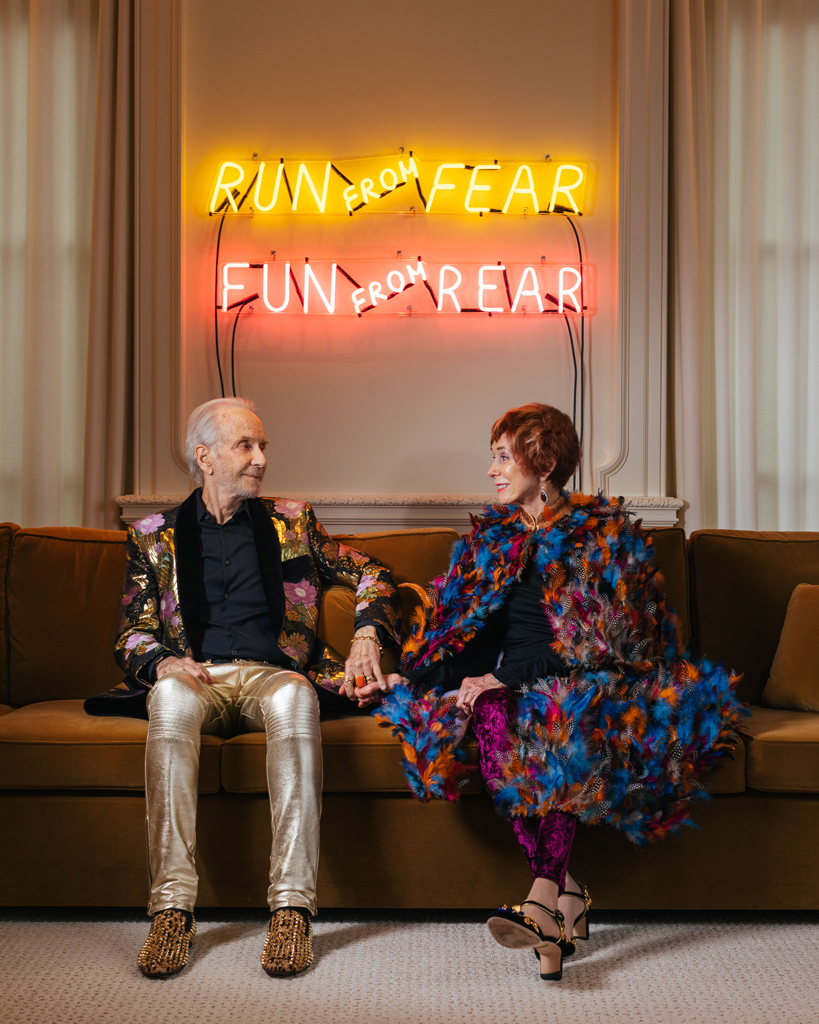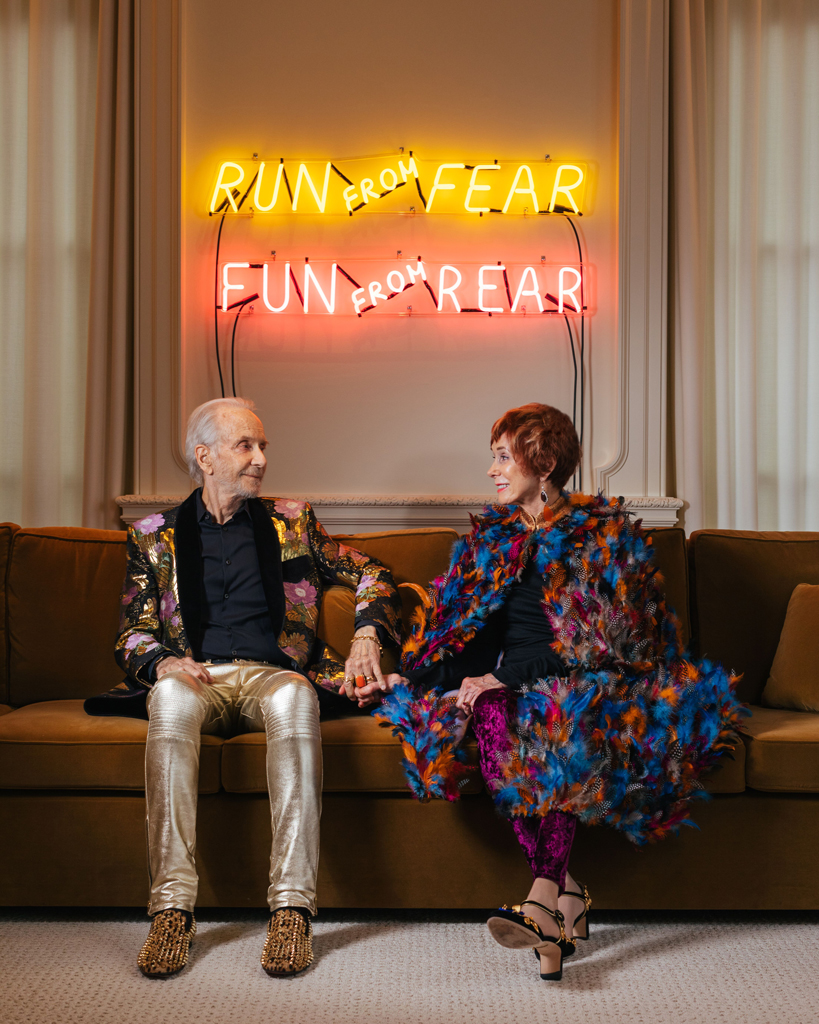[ad_1]

Norman and Norah Stone in January 2019.
©PETER PRATO
Norah Stone, a prominent philanthropist and art collector in San Francisco who, along with her husband Norman, has ranked on the ARTnews Top 200 Collectors list each year since 1995, died on September 6 at age 81. The cause of death was cancer. Charles Desmarais first reported the news in the San Francisco Chronicle.
The Stones, who began collecting art in the early 1990s, were known for their eye-catching—and at times outlandish—complimentary outfits. They were inspired to become art collectors through their interactions with John Caldwell, a curator at the San Francisco Museum of Modern Art throughout the 1980s until his death in 1993. Both Stones would serve on SFMOMA’s board of trustees over the years.
For the couple, who married in 1986, collecting was a joint effort. “Collecting brings us closer together,” Norah said in 2016 interview with Architectural Digest. “You won’t always agree, but you know you have to make decisions. That’s life really.”
As part of a survey conducted by ARTnews with its Top 200 Collectors in 2017, the Stones pointed to a few prized works as the cornerstones of their collection: Joseph Beuys’s Vitrine with Plateau Central (1962–80); Jeff Koons’s Large Vase of Flowers (1991), as well as his Balloon Dog (1996); a version of Marcel Duchamp’s L.H.O.O.Q., in which the artist has drawn a mustache on a reproduction of the Mona Lisa, plus a trio of the Dadaist’s “Erotic Objects” that is related to the artist’s famed final work, Étant donnés. Their first purchase as a couple was John Baldessari’s A Painting That Is Its Own Documentation (1966–68).
“We never intended to collect pretty pictures,” Norah told SFGate in 2000. “We’ve never shied away from collecting difficult pieces. I not only like to be challenged, I like to challenge other people.”
Indeed, the Stones’ approach to collecting differed drastically from their peers in the Bay Area, particularly Doris and Donald Fisher, the founders of Gap, whose collection of postwar art focused in-depth on specific artists, many of whom are white, male, and represented by blue-chip galleries. (Much of the Fisher’s 1,100-work collection has been part of a 100-year loan to SFMOMA since its reopening in 2016.) “Don Fisher had a delimited perspective for his collection that was very much his own,” Thea Westreich, the Stones’ longtime art adviser, told ARTnews.
When the Stones were starting out, San Francisco was a “very conservative community that collected only what smelled, looked, and felt like art,” Westreich said. “The Stones really wanted to know what was happening in the world now. They loved the unusual art that paved new territory, and asked provocative and compelling questions.”
The couple’s approximately 1,000-work collection runs the gamut of contemporary art. Though conceptual art, from its grandfather Duchamp to later practitioners like Beuys, form the core of their holdings, the Stones also collected across a spread of styles, mediums, and approaches, picking up works by Donald Judd, Vito Acconci, Robert Gober, Mike Kelley, Matthew Barney, Alex Israel, Hito Steyerl, Liz Deschenes, Seth Price, Amalia Ulman, Aaron Flint Jamison, and Anna Uddenberg over the years.
When the couple first start building their collection, their intention always was to donate it to a museum, preferably SFMOMA. In the SFGate interview, Norman said, “We realized that these objects weren’t going to be available to the museum unless some people like us bought things that would end up going to public institutions. This is not for sale. It’s not an investment.”
Norah Sharpe was born in 1938 in Alberta, Canada, where she studied nursing before moving to the Bay Area to work in hospitals during the 1960s. She also volunteered to supervise the nursing staff at the Haight Ashbury Free Clinic in San Francisco when it opened in 1967. Later in life, Norah would get her law degree from the San Francisco Law School and worked as a corporate attorney.
She met Norman Stone, a psychotherapist who was the son of a Chicago insurance billionaire, on a blind date in 1984 and they married two years later. Early in their relationship, Norah realized that Norman took special care in the way he dressed, often outlandishly. This extroverted garb would become their signature style, and the couple could be spotted wearing their unusual clothes at art fairs, biennials, and beyond. In a 2012 interview with the San Francisco Chronicle, she recalled Norman asking her, “Don’t you realize that every day is a costume party?” It was that approach, she said, “that gave me permission to be creative and wear what I wanted to wear, not what other people thought I should wear.”
“The same dedication to buying art went into buying fashion,” said Westreich, who noted that Norah had a passion for the color red. “It was thought through and considered.”
Together Norah and Norman Stone would go on to build one of California’s most important collections of contemporary art, and it would span their home in San Francisco’s tony Pacific Heights neighborhood and Stonescape, their 17-acre property in Napa Valley purchased in 1991 that includes an active vineyard, a farmhouse, and large-scale sculptures, including a Cady Noland log cabin and a James Turrell installation centered around an infinity pool.
To install the Noland work at Stonescape, the Stones had to design an asphalt road that leads only to the cabin, per the artist’s request because Noland likes “the smell of hot asphalt in the summer,” the Stones said in a recent unpublished interview with ARTnews. (The property has gravel roads otherwise.) To find the perfect spot, Norah drove around the property with Noland. Norah recalled that “each time while [we] were driving, Cady said, ‘I get carsick on curving roads.’ ”
And like the art collection, the Stones were always ones to create a sense of fanfare about art and about life. “If you watched how they lived, dressed, ate, even—ordering dinner was a theater production—everything was high on drama,” Westreich recalled. “They are as curious as any two people I’ve ever worked with, who were always willing to see more, learn more, and do more.”
Westreich continued, “Norah had a passion for art, fashion, and life in general—a huge appetite for living and the energy to do it. It’s almost impossible to embrace that someone so alive and vibrant is gone.”
[ad_2]
Source link

